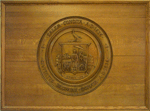Sanderson, Elijah and Jacob
Elijah and Jacob Sanderson were premier furniture makers from Salem. They are often seen in the shadow of the great woodcarver
Samuel McIntire but they were esteemed in their lifetimes.
"Since Salem had been a shipbuilding town as early as 1636, here was a community with artisans thoroughly trained for furniture-making.
It should not be forgotten that there was a close bond between shipbuilding and the craft of furniture-making" according to Collector's Weekly article.
According to the article, "there were in this seaport town, between 1780 and 1837, the year of the first city directory, at least a hundred craftsmen with their own shops. Essex,
North, Court, Federal, Liberty, Chester, Mill, Boston, Charter, and Derby streets seem to have been the favorite locations, with those on Essex Street far outnumbering the rest.
The firm of Elijah & Jacob Sanderson was a very important shipper of Salem furniture both in the coastwise and foreign trades. This partnership consisted of three men —
Elijah and Jacob Sanderson and their partner, Josiah Austin. All were cabinetmakers by trade.
Elijah and Jacob Sanderson were born in Watertown, Massachusetts, in 1751 and 1757, respectively. By 1779, having served their apprenticeships to some unnamed cabinetmaker in their home town,
had reached Salem and formed a partnership with Josiah Austin. As early as 1788 they began shipping Salem furniture twice a year.
Through their collaborative business, and with half-shares in several Salem ships themselves, they sent cargoes of furniture to the Southern seaports, the West Indies, Africa,
and India in a series of voyages that are well-documented in the Phillips Library documents.
Jacob died in 1810, Elijah died on Feb. 19, 1821.
See Also
The Sandersons and Salem Furniture Collector's Weekly, March 28, 2009.
Artists and Craftsmen of Essex County Essex Institute, 1927, p. 68
A cabinetmaker is captured Streets of Salem blog.
Essex Institute Historical Collections Vol. 70, Oct. 1934, p. 323-364
